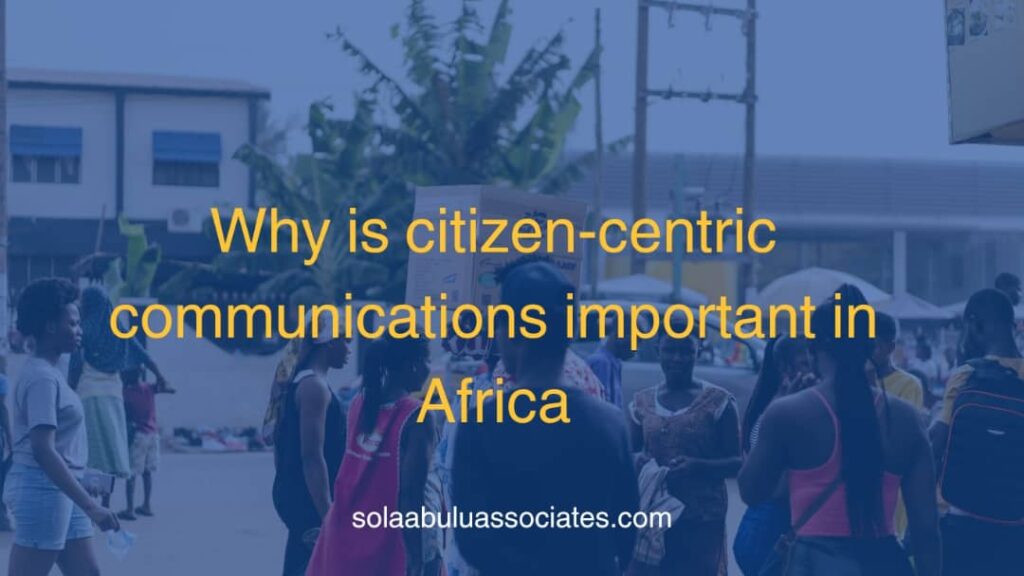Citizen-Centric Communications in the African Public Sector?

Every communication done whether in the political sector, public-policy, business world or even corporate organizations, is done for an audience. Citizen-centric communications in simple terms is to tailor every communications effort and messaging with priority on the citizens.
According to Sola Abulu, “I would define this as prioritizing citizen’s issues, needs and interests in communication and stakeholder engagement and striving for a win-win approach in terms of the government’s political, policy or public sector administration agenda.”
This approach places the citizen as the core target audience and the communication strategy is tailored to the interests and concerns of identified segments within the population, based on the issues or agenda at hand.”
Citizen-centric communications prioritize the citizens of a state or nation as key audience and recipients of public sector policies and governance. The citizens should be regarded as first when it comes to public policy and political communications. This is why stakeholder engagement and management is important because proceeding to communicate after policies are made without engaging the people is assuming you know what your audience needs which is not always so. This approach to public-sector policy and political communications emphasizes and highlights the rights, duties and responsibilities of citizens and the government’s role in protecting it.
However, there are cases in African political and public-sector policy communications that show a decline and less of attention in adopting this approach to communications. This article will focus on examples from Nigeria and Kenya.
On 1st of April 2024, the Nigerian Electrical Regulatory Commission (NERC) announced a 300% increase in electricity tariffs for consumers in Band A. From the source referenced here, the communication which made by the regulatory body for the general public successfully passed an information but it cannot be said if they achieved the objective of passing across an easy-to-understand message that considers the citizens of Nigeria which does not only comprise of educated elites who may understand complex terms like this but the poor majority of the country. After this release was made, many Nigerians have been left to figure out the complexity of this, the reason for the decision, etc. This is what citizen-centric communications entails.
Another classic example in Nigeria is the Central Bank of Nigeria (CBN) with a communication that reveals that their identified major stakeholders are the banks they regulate before the citizens that they serve. This has resulted in the release of memos containing policies for the banks but with the Nigerian citizens in copy; however, the messaging is not always simplified enough to achieve understanding from those not within this sector. Although CBN also utilizes social media as a communications tool, memos like this are documentary evidence but infographics should be deployed as well because these links are not as shareable as stand-alone graphics are. Links require clicks and bandwidth while graphics are immediately in your audience’s face. In this example, the language should differ; that is, the same language used for the banks should differ from the language used for the citizens. A citizen-centric communication effort will have less jargons in its messaging and will adopt explainer communication techniques.
Also, the event in Kenya that led to a protest this year emphasizes the need for citizen-centric communications. With a population of over 56,000,000 people in Kenya, shows the effect of bureaucratic communications in the public sector and intolerance of the citizens. You can read about the Kenyan finance bill that led to citizens protests here.
You will find this article on Effective Public Sector Policy and Political Communications in Nigeria and Africa by Sola Abulu, very useful. A government agency that demonstrates citizen-centric communication is the Nigerian Bureau of Statistics. They make use of explainer content like visuals and infographics to break down the message for the public.
Two things to do better to achieve citizen-centric communications
- Use explainer communication techniques (data visualization, infographics, etc.) to break down the message.
- Utilize stakeholder mapping to engage different stakeholder groups differently through different channels.
- To achieve a communications effort that is citizen-centric demands a lot of diligence in messaging to ensure that the citizens are well carried along in policy making and political policies through the stakeholder engagement, targeted communications channels and simplified language/tones.
Citizen-centric approach to communications shows respect for the citizenry. Lack of this approach often shows a disconnect between government agencies, political leaders/groups and the people. To learn more about the importance of citizen-centric communication in public sector administration, policy and governance, watch this recorded webinar. To take our on-demand course on Public Sector Policy and Political Communications and receive a CPDSO-Accredited Course Certificate on completion of the course, click here to register.
……………………………..
Sola Abulu & Associates is a strategy and communications training and consulting firm focused on enabling businesses, brands and institutions to achieve their desired objectives through strategic communications and reputation management.
